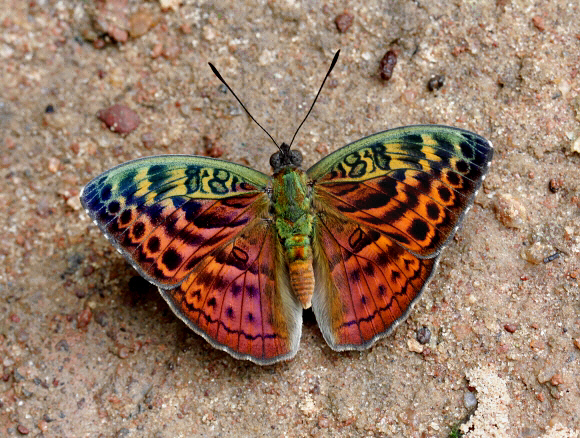
Introduction
There are about 95 Bebearia species, all of which are wholly Afrotropical in distribution.
This page provisionally describes a new taxon discovered on 15 September 2012 by Adrian Hoskins at Bobiri Forest Reserve in southern Ghana.
A full scientific description will be produced in due course. Meanwhile, I am releasing the following information in the hope that further specimens will be captured and made available for study.
The males of several Bebearia species have a fritillary-like pattern of dark spots on a brownish or orange ground colour. The tentyris group comprises of 6 currently described species i.e. carshena, tentyris, subtentyris, winifredae [ = osyris ], lucayensis, and dallastai. The males of this group are briefly discussed below for comparison with this newly discovered member of the tentyris group.
In this group of species, the dark spots in spaces 1a and 1b of the outermost transverse bands on the forewings are angled sharply inward, whereas in the most closely related zonara group these bands continue in a straight line from the base of space 3 to the inner margin.
Bebearia subtentyris has a dull earthy brown ground colour, and a faint violet iridescence visible at extreme angles of lighting. The smaller species tentyris has a warmer brown ground colour with a blue iridescence over the forewing cell and costa, with the remaining areas reflecting a coppery hue. Intraspecific variation is very minor, and does not affect the iridescence. In winifredae the entire forewing and most of the hindwing reflect a dull metallic blue sheen. In dallastai, the male has both wings wholly covered with a sustained blue. In lucayensis, the ground colour is orange-brown with a barely visible purple sheen covering both wings. In carshena, the ground colour is dark brown with a strong blue iridescence over the entire surface of both wings. Members of the tentyris group known previously in Ghana are winifredae, lucayensis, tentyris, subtentyris, and carshena. All 5 occur at Bobiri, with tentyris being abundant and the others uncommon or scarce.
The taxon visually closest to sp nov B97 is subtentyris languida. The markings, however, differ, and the ground colour and the hues reflected by the structural scales of B97 are unique. The upperside is bright peach, with the hindwings and spaces 1a, 1b, 2 and 3 of the forewings overlaid with a deep violet-blue iridescence. The strongly defined area of iridescence in the discal cell and in spaces 4-12 of the forewings is bright ochreous-green. This colour is also present on the thorax and abdomen. The differences in structural colour between B97 and previously described taxa cannot in the writer’s opinion be attributed to intraspecific variation or aberration. The wingspan of the male is circa 7cms, i.e. significantly greater than that of tentyris, and about the same as subtentyris.
The female is unknown, but it is reasonable to assume that in common with others in the tentyris group it will almost certainly be found to have a Catuna-like pattern in dark brown and cream.
The unedited images shown on this page were photographed by natural light in sunlight and shade, and the colours are reproduced exactly as they appeared in the field.
Habitats
The habitat at the type location is mildly degraded humid rainforest.
Lifecycle
Unknown, but the larval foodplant will probably be Hypselodelphis or related Marantaceae.
Adult behaviour
The illustrated male was observed on a logging road, where it spent several minutes basking on the ground in full sunlight. This behavior is quite unlike that of tentyris and subtentyris which in the writer’s experience confine themselves to areas where dappled sunlight filters through the canopy to ground level, and only appear in open areas in warm but overcast conditions.

